under the copyright of The Seattle Times)
TID:
Erika, thanks for taking the time to speak with us. Please
tell us a little bit about the background of this week's
featured image:
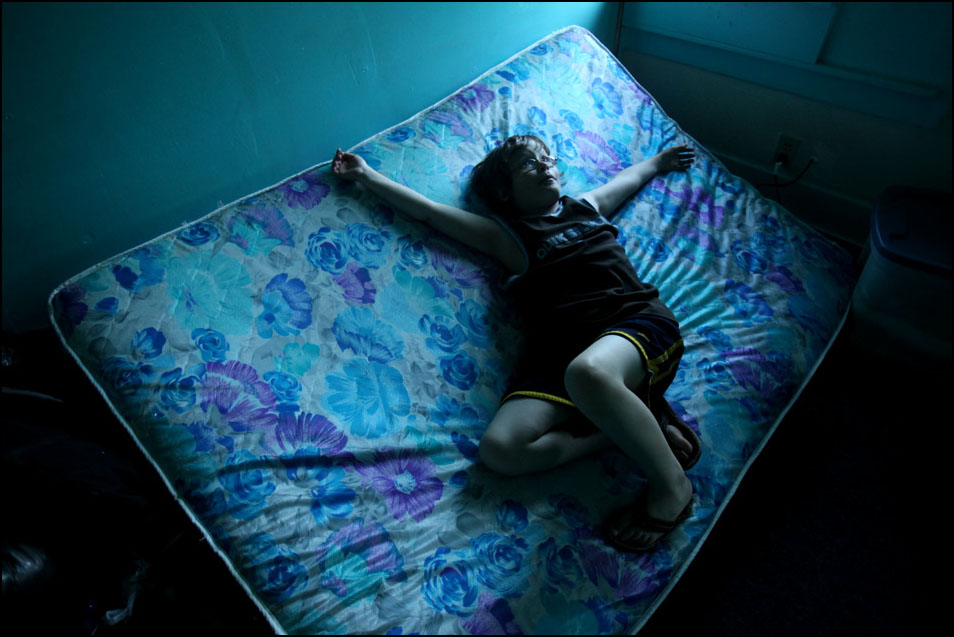
ERIKA:
Ross, thanks so much for creating The Image, Deconstructed.
It’s an inspiring and valuable resource for the photojournalism
community.
Kim moved her two sons— including Jack, 9— from Chicago
to Seattle in April 2010 after looking for work for about a year.
Kim had heard there were good job opportunities in the
Northwest. But the housing vouchers she had been counting
on never materialized. They soon moved into a tent city called
Nickelsville, and tried to establish their lives in a new city with
very little.
This photograph of Jack was taken as he moved from the tent
city into the room his family was renting in the University District.
After weeks of living without running water or electricity, Jack and
Kim finally had a room of their own, and a kitchen and bathroom
to share with other residents on their floor.
The photo essay about Kim and Jack’s journey published in The
Seattle Times in August 2010 as part of the final installment in a
three-day, multiplatform series called “Invisible Families.”
You can see the gallery: http://bit.ly/mPtrV9
The Invisible Families project page: http://bit.ly/affjhJ
After meeting Kim and Jack at Nickelsville tent city, I soon
realized they had a strong relationship. They constantly joked
with one another and were very affectionate. Kim was warm,
open and funny. Jack was curious, imaginative and gregarious.
During their time at Nickelsville, she worried about providing
Jack a normal childhood through this difficult transition.
They spent the majority of their money moving across the
country. Some evenings, dinner was made over a campfire.
Taking a shower sometimes meant walking a couple miles
to a community center.
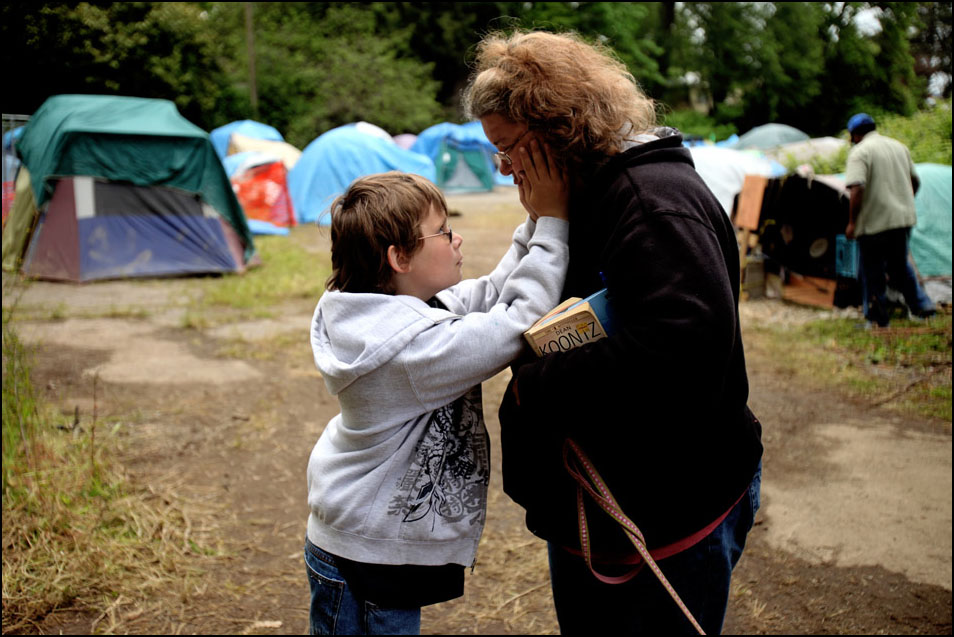
(Jack and Kim share a moment while living in the tent city. Kim read
online that jobs would open up in Seattle at the end of the recession.
Without lining up a job, she moved to Seattle hoping to find secretarial
work and a fresh start.)
I wanted to try to share a realistic and personal glimpse into a
family that was trying to maintain a sense of normalcy while
homeless. I also wanted to show their relationship and humor as well
as their quirks — like Jack’s love for the paranormal and his ability
to enlist other tent city residents to look for worms.
TID: Since this image is part of a larger story, please talk about
that story, and how this image fits in within the story.
ERIKA:
Reporter Lornet Turnbull and I started working on the project in the
spring of 2010 and it published at the end of that summer. Journalists
from within our community, including The Seattle Times, produced
stories about family homelessness as part of a fellowship
administered through Seattle University and funded by the Bill &
Melinda Gates Foundation.
The foundation said it sponsored the fellowship to focus attention
on homeless families, which are the fastest-growing, yet least visible
segment of the homeless population, both in Washington state and
nationally. It did not stipulate how fellows should pursue their work,
nor did it review what the fellows produced. Each fellow was granted
a $15,000 stipend. The Times used its stipend in part to enable a
staff member to serve as project manager of contributions from the
paper's online news partners. Our director of photography approached
me to work on the project after The Times received the fellowship.
While working on the project, Lornet and I talked to dozens of
organizations, caseworkers and families, both gathering information
together and separately. For weeks, we returned to shelters and
social-service organizations in search families who could share their stories.
I kept coming back to Nickelsville because I heard it was the only
tent city in the area that accepted families.

(Kim kisses Jack inside their tent during bedtime at Nickelsville.
"Our nighttime ritual is goodnight, I love you," she said. She made
their sleeping area out of a feather bed, couch cushions and more
than a dozen moving quilts.)
I met Kim and Jack while they were working at the tent city’s security
desk. Kim told me a little of their story, and I let them know about our
project and some the parameters it would include. After parting ways,
I was both hopeful and nervous. I thought they had a good story, and
hoped they would be open to sharing it.
Soon after our conversation, Kim agreed to be a part the project. We
discussed the importance of capturing candid images that could
communicate both big and small moments in their lives.
Kim really embraced it. She let me know when they were
taking showers at the community center, doing laundry at The Urban
Rest Stop and later when they were looking for apartments. I still find
it amazing how well she kept in touch, despite all of their stress and
hardship.
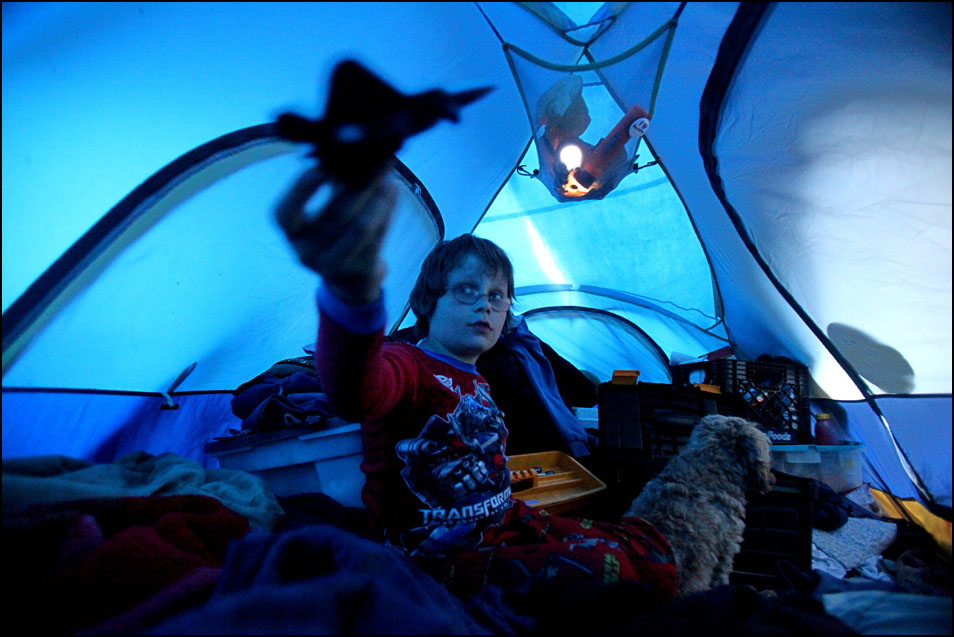
(With his flashlight and family dog close by, Jack plays with his toy
plane before falling asleep in his tent at Nickelsville. He wears
“Transformers” and “Star Wars” pajamas.)
After we first met, they stayed in Nickeleville for about two weeks before
Kim found several agencies to help them secure a deposit and first
month’s rent for a room in the University District.
When the big day came for them to move, I knew when it was happening
and that I was invited to be there. Because we had developed trust and
understanding, I knew I could focus on the moments of the day through
photographs.
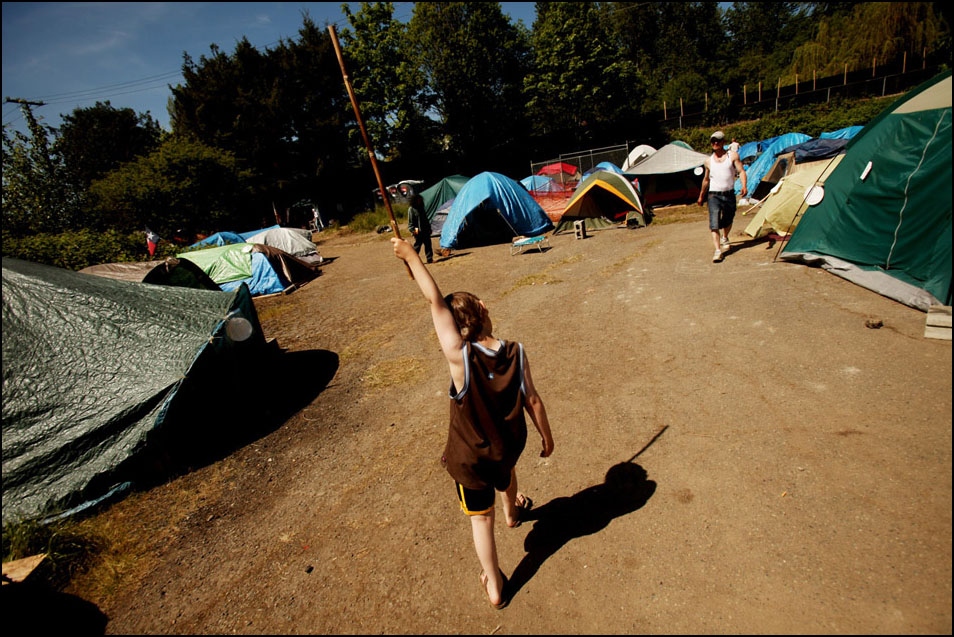
(The day of the move, Jack marches through Nickelsville with a
bamboo stick given to him by a fellow resident.)
TID:
Ok, now onto the image itself. Tell us what led up to the moment
at hand, and also what was going on while you made the image.
ERIKA:
This image of Jack was taken while they were moving from Nickelsville
in South Seattle to their rented room in the University District.
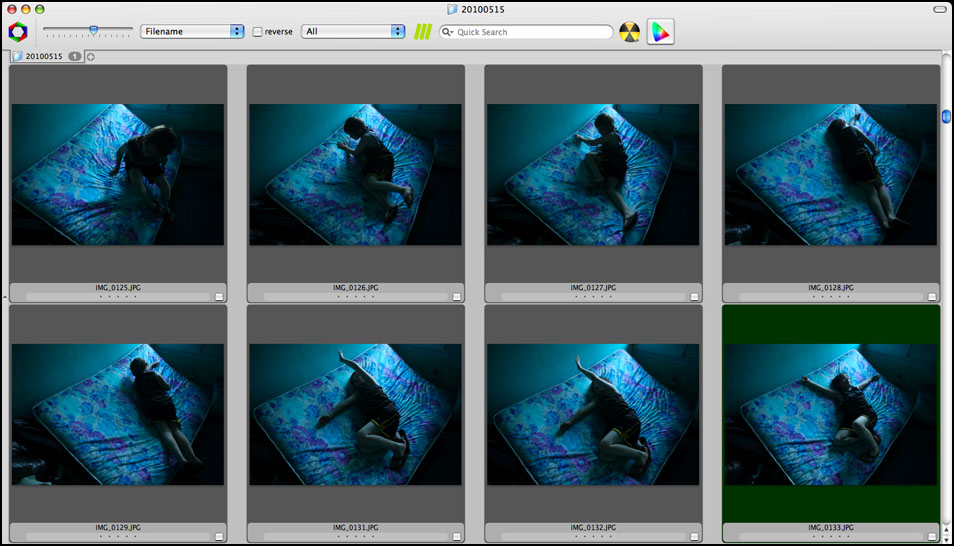
Once their bed was brought up a long staircase and into their room,
Jack immediately jumped on the bed. He wriggled around for a bit,
stretched out for a few moments (This is when I took the photograph)
and then reached for a soda. We talked about how he was feeling in
the new place. He played with a bamboo stick and his dog, Gracie.
Then he returned to moving.
Early on, while working with Jack, I realized that sometimes I could be
a fly on the wall. But other times, he wanted to talk and interact. Did
you see that spider? Guess what my brother is doing? Can I play with
your camera? Do you know there are werewolves hiding in the bushes?
I sometimes photographed Jack during these conversations. I'm not
a fly on the wall when I photograph people. I want to listen to Jack's
frustrations and achievements. Have lunch with him. Tag along when he
looks for worms and bugs. Photograph him as his mom tucks him in for the night.
I feel the more time you spend with people the better. It helps develop
a better understanding of who they are, and more times than not,
it can lead to a photograph.
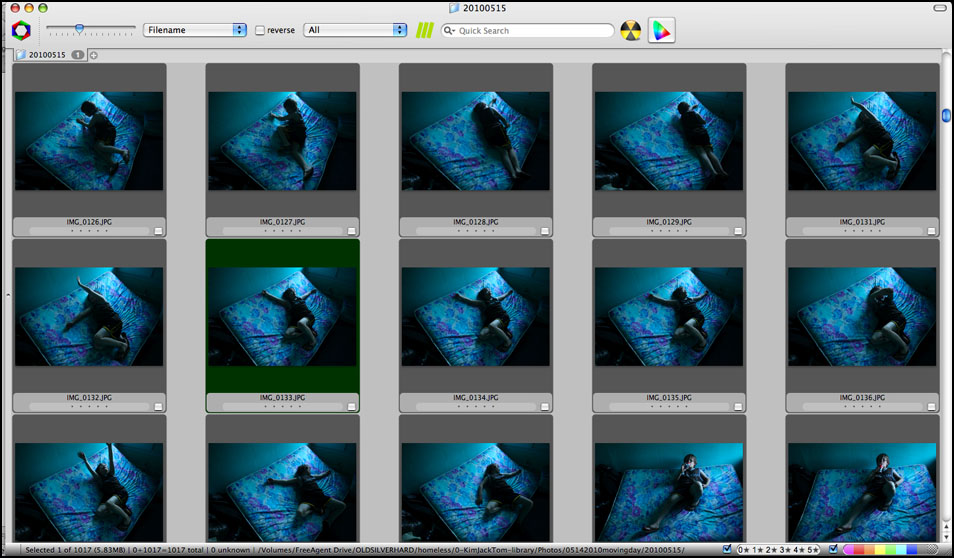
TID:
Was there any point of conflict during the making of this picture, or
during the story, and if so, how did you manage it?
ERIKA:
Homelessness and poverty are complex topics. I think one of the
challenges our reporter, editors and some of the multimedia storytellers
faced with the project was to how to share multiple perspectives of
homelessness.

(Most of their goods were stored in bags when moving. Kim, Jack, their friends
and Jack’s older brother Tom — who was around for only part of the time
during the story — took turns hauling up clothes and other items.)
Through a variety of mediums we tried to touch on issues involving a
lack of affordable housing in our region, the plight of refugee families,
single fathers, the working poor, programs in schools and workings of
the homeless support system. Even though we covered a lot of ground,
I think it’s challenging to concisely package the causes and solutions of
family homelessness in a three-day series. I think it takes continued
coverage.
While working with other families in the series (not with Kim and Jack)
I learned that homeless parents sometimes grapple with a variety of
issues. They can be stressed, scared, depressed and have drama in their
lives. Sometimes they don’t take opportunities to help themselves.
Sometimes they may not know all of the resources available.
And not all of their decisions make sense to someone outside their
situation. At times, I wondered if one family was telling the truth. It was
difficult to keep track of another. Other families had histories of substance
abuse. At points, I received phone calls and texts during all hours of the
day and night. So, I often leaned on my colleagues and editors to help
me to navigate these interactions. My purpose is to be with families as
a journalist, not a social worker. So during parts of the project I struggled
with guilt and frustration because I hadn’t been in some of these situations
before.
There were a lot of considerations while working on Kim and Jack’s story,
as well as other families' featured in the series.
We realized that caseworkers are sometimes protective of their clients,
because the families may be stressed or dealing with trauma. They may
want to refer you to a family who was previously homeless, versus a family
who is currently homeless.
Some parents feel fine discussing their struggles. But if their child or
one of the siblings does not want their friends to know at school, we
then knew they shouldn’t be involved in the project.
Other families may not want to be labeled as homeless. One of our
families in the series had second thoughts because they were nervous
about being the public face of homelessness. They were embarrassed
about their situation. They saw it as only temporary.
How much help we could provide to families while reporting
was also another important consideration.
Is it okay to purchase a meal for a family? Should we tell a family
about service providers that could help them in their area? Would
it alter the course of a family’s path by sharing certain resources?
Can we intervene in a story if a family is looking for a safe place to
spend the night? Can we help them after the story publishes?
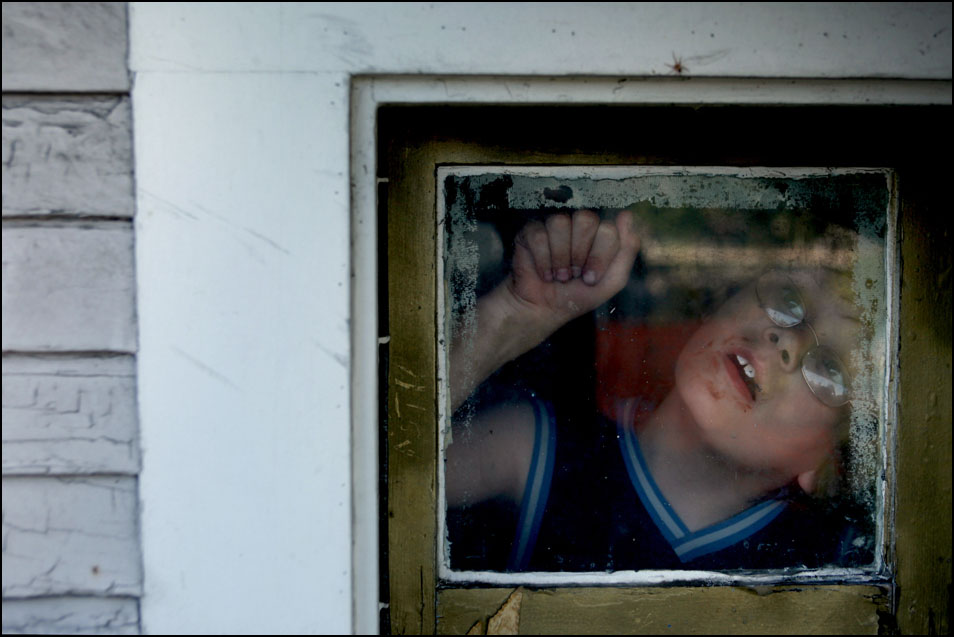
(One of the first things Jack finds at their University District
apartment is a spider. Jack is seen through a small window
next to the front door. "They [the bugs] are amazing," Jack said.)
TID:
Was there any concern about you taking this picture at the
time, and if so, how did you handle it? (You mentioned the concept
of photographing children.)
ERIKA:
While working on this project, we realized that kids would
likely be placed in the most sensitive position during our coverage.
With some of the families, we discussed scenarios that could occur
after the story published. We listened to their concerns, and tried to
address those issues the best we could before starting to work with them.
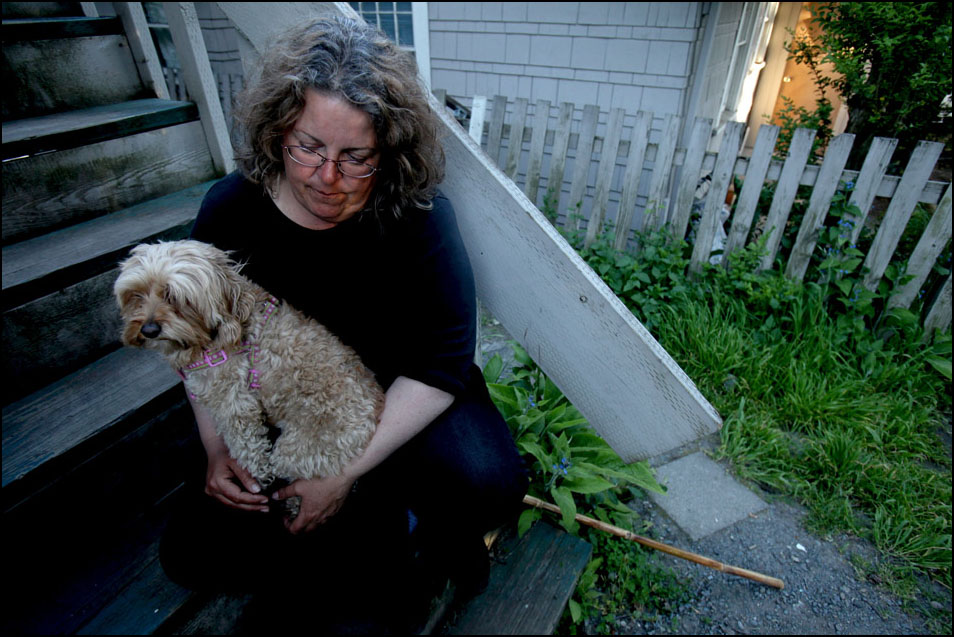
(Kim takes a break while moving into her new apartment with her dog Gracie.)
There were a handful of families who decided they didn’t want to
be a part of the project after learning more about it. We acknowledged
that school aged children could be teased by their peers after the
story published.
But we also discussed possible positive outcomes of sharing
their stories. Media coverage can increase the public’s awareness
of family homelessness, encourage community dialog and possibly
help others in a similar situation.
After the project published, I learned one of the families wished to have
their last names removed from the online stories. Overall, they had a good
experience with the project. But they didn't want the names to always
be linked to story and to the fact they were homelessness during one point in their life.
One of the effects of online reporting is that subjects with sensitive stories
may be linked to these articles for perpetuity.
TID:
What lessons did you learn from making this image?

ERIKA:
I think this photo was created more by relationships than by
mechanics. Over a period of a couple weeks, Kim, Jack and I
had spent a lot of time together. By moving day, they both
seemed to be unguarded and open to my presence in their
lives. But I think our relationship worked twofold. Because
we developed trust, I felt like I could work without any major
insecurities or doubts. I felt like I had permission, a purpose
and an understanding of who they were.
TID:
What lessons did you learn from the overall story, and with this,
how did you change during this experience?
ERIKA:
As of last year, I worked at The Seattle Times for about four
years, which isn’t all that long as a professional journalist.
Through this project, I learned to have more trust in my voice
and ideas as a storyteller, but also to rely on the support and
experience of my editors and colleagues. I believe that because
we worked together, and told stories through a wide variety of
mediums in print and online, we were able to give depth and
multiple perspectives to a very complex problem. I think there
is a lot of power in collaboration.
I also think my love for community journalism, and my belief in
the power of it, grew after this project.
TID:
In conclusion, what advice (think mentally) do you have for
photographers to gain access to these type of situations?
ERIKA:
It’s important for photographers to be active in the reporting
and researching process. Photographers should initiate meetings
with sources and compile their own research while working with
a reporter. By being proactive as a visual storyteller, you can
put yourself on the path to telling more informed and visual stories.
Through this process, I’ve learned stories will inevitably fall through
and hit snags. It happened frequently during the series. But it’s
important to try to keep positive and realize that better stories and
situations will come if you keep searching.
Often the most difficult work wasn’t taking the photographs, but
putting myself in the physical or mental space to make them. I learned
it’s important to trust my instincts about people. Try to set boundaries.
And, in hindsight, I realized it’s good to take mental breaks from the
project.
Also, I think it’s important to have a conversation with the subjects
in your stories about what it would be like for them to take part in a
documentary project. I think it’s helpful to let them know the purpose
of the story, how much time you’d like spend time with them, when
you’d like to spend time with them, where you’d like to see the photos
published (web or in print) and the possible outcomes/reactions to the
story.
And I think it’s super valuable to bounce off ideas and share images
with an editor and peers you trust while working on a project. During
difficult days, I often got strength and rejuvenation from my colleagues,
which I am extremely grateful for.
A year later, Kim and Jack are doing really well. Kim found full-time
work and Jack’s elementary school is helping him both academically
and emotionally. They found permanent housing.
+++++
You can view the multimedia project, edited by Danny Gawlowski:
http://bcove.me/j8mdn64h
BIO
Erika Schultz was born and raised in central Wyoming. She attended college at Northern Arizona University, and works as a Seattle Times staff photographer. She loves the American West, Spanglish, well told tales and to travel.
Her work has been recognized by the Casey Medals for Meritorious Journalism, National Edward R. Murrow Awards, The Alexia Foundation for World Peace, Society of Professional Journalists and was a finalist for the 2010 ASNE Community Service Photojournalism award. She also was part of The Seattle Times’ 2010 Pulitzer Prize winning team for Breaking News Reporting.
Invisible Families:
http://seattletimes.nwsource.com/flatpages/local/invisiblefamilies.html
You can view more of her work here:
http://www.erikajschultz.com/blog/
+++++
Next week we'll feature this surprising image by Gerry McCarthy:
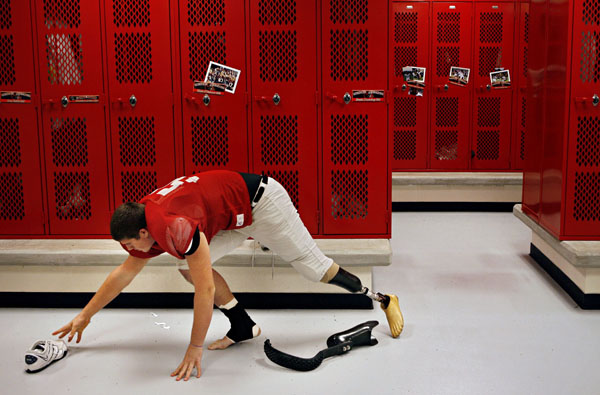
As always, if you have a suggestion of someone, or an image you
want to know more about, contact Ross Taylor or Logan Mock-Bunting:
ross_taylor@hotmail.com
logan@scott-free.com
For FAQ about the blog see here:
http://www.imagedeconstructed.com/
the images show the way children are able to appreciate life through their curiosity and imagination. Where an adult would be sinking into depression, the child would be looking for new adventures. I am not sure what my favorite image is.. the boy with the plane in the tent has a magical quality as well as the boy with his hands on mom's face. Awesome job, Ericka!
ReplyDelete